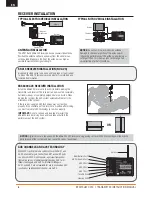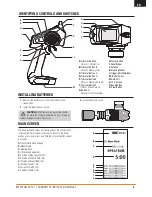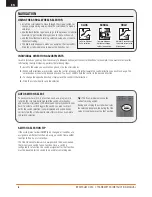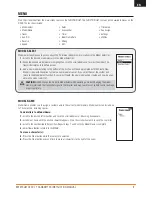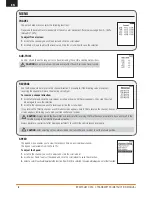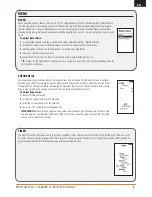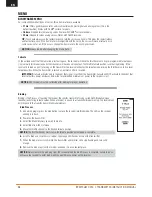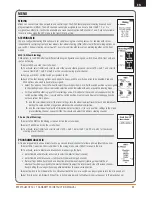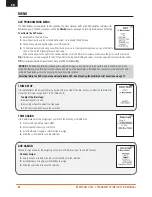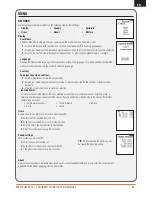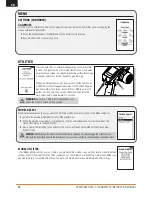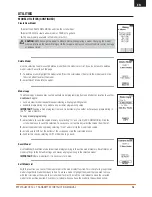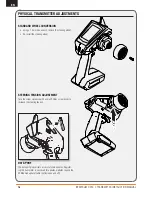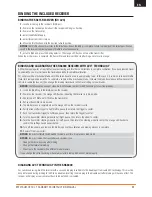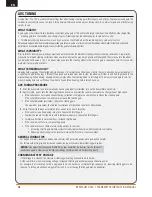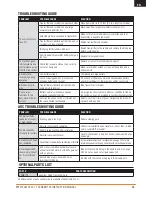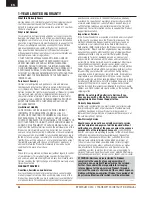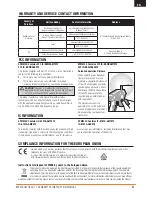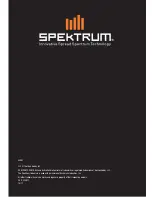
18
SPEKTRUM DX5C • TRANSMITTER INSTRUCTION MANUAL
EN
NOTICE:
If you adjust the steering and throttle trim on your transmitter, the receiver must be turned off
and back on again in order to save the new trim settings. Otherwise, AVC will not function properly.
AVC TUNING
A value from 0 to 100 is used for three settings that affect tuning; steering gain, throttle gain, and priority. These values confi gure the
receiver to your vehicle so you can tune it for optimal performance based on your driving style. It is normal for gain and priority tuning
results to vary.
WHAT IS GAIN?
A gain value of 0 will result in zero electronic corrections, and a gain of 100 will result in large corrections in an effort to hold a straight line.
• Steering gain tells the receiver how strongly to assist steering when the vehicle begins to spin out of control.
• Throttle gain tells the receiver how much it can assist on the throttle when the vehicle begins to spin out of control.
Default gain values are 50. We recommend adjusting gain values 5 points at a time. Fine tune the settings with smaller increments as desired
performance is acheived. Avoid large increases to steering gain values between tests.
WHAT IS PRIORITY?
Priority tells the receiver how much you want to be able to override the electronic stability with your steering commands. A low priority
means AVC will make steering corrections when you turn wheel all the way. A high priority will reduce AVC the more you turn the wheel.
The default priority value is 100. This means when you turn the steering wheel to the limit, the gain is reduced to zero. This value will
work well for a majority of drivers
WHAT IS HEADING HOLD?
Heading hold maintains the selected vehicle direction. It is normal to see the wheels steer in the same direction it was last pointed. If
a vehicle with AVC technology is lifted off the ground and turned from side to side, the wheels will steer in an effort to get back to the
original heading. When driving, heading hold only works when the steering wheel is left straight. The moment you begin to turn the
wheel, heading hold turns off. When the wheel is re-centered, heading hold is turned back on.
AVC TUNING PROCEDURE
1.
With the transmitter and receiver already bound and properly calibrated, turn on the transmitter and vehicle.
2.
Apply throttle, do not turn the steering wheel, and observe how well the vehicle can maintain a straight line at high speed.
• If the vehicle does not make enough steering corrections to maintain a straight line, increase the steering gain.
If the vehicle fi shtails due to wheel-spin, increase the throttle gain.
• If the vehicle wobbles (oscillates), reduce the steering gain.
The maximum gain values that prevent oscillations at high speed should not be exceeded.
3.
Drive the vehicle through accelerated turns and observe how it responds.
• If the vehicle slows down going into a turn, reduce the throttle gain.
• To allow the vehicle to slide more with intentional wheel-spin, reduce the throttle gain.
• To improve traction in slick conditions, increase throttle gain.
• If the vehicle won’t turn-in, increase the priority.
• If the vehicle spins out, there are two tuning options to consider;
1. Increasing throttle gain will help correct for undesirable wheel-spin when the vehicle over-rotates.
2. Reducing priority will give the receiver more authority to help correct oversteer.
GENERAL TUNING TIPS
For beginner drivers, looser conditions, and vehicles with excessive power, more gain will be helpful.
For terrain with more grip and increased speeds, tuning will result in lower steering gain values.
CHANGING BATTERY VOLTAGE
If the voltage is increased, the maximum steering gain setting will have to be reduced.
At the same time, when incereasing voltage, increased throttle gain will help manage the extra power.
For example: If a truck set up for 2S is upgraded to 3S, the truck may oscillate at high speeds on 3S, requiring steering gain to be
reduced. Throttle gain will have a bigger effect on 3S, so increasing throttle gain may be benefi cial.

